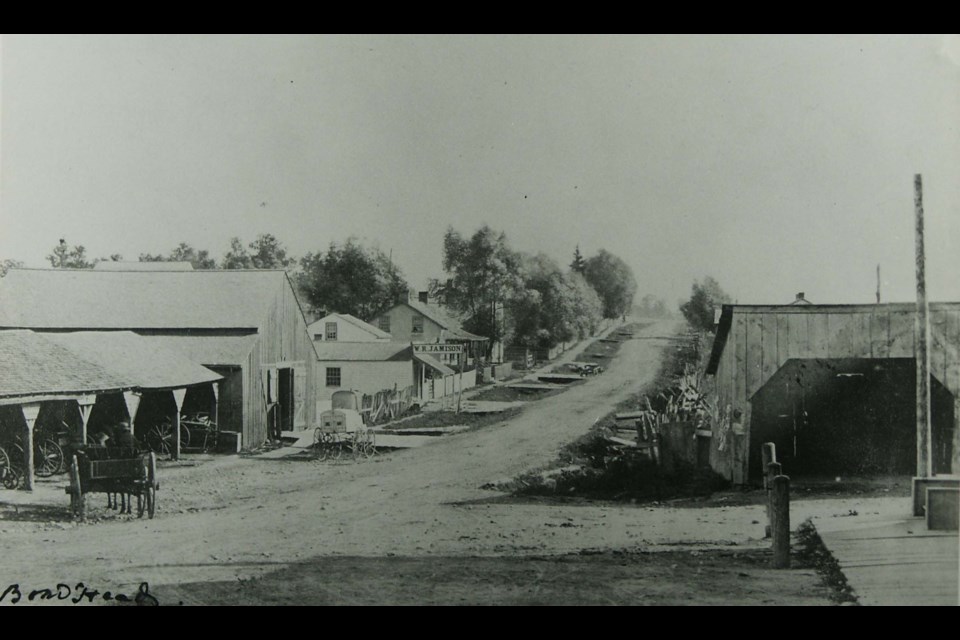When Canada officially became a country in 1867, Bradford West Gwillimbury was already 10 years old with a community of about 1,000 people.
Bond Head, considered one of the oldest hamlets in Simcoe County, was even older — turning 30 the year of Confederation.
While the country was coming together, more than 20 businesses were already established in BWG, finding their places along the area’s dirt roads and not far from the Grand Trunk Railway’s Bradford stop.
The outlook was already looking positive, according to a South Simcoe News article from July 4, 1867.
“Henceforward, the four millions of British subjects upon this continent will exist but as one people. … We believe it is pregnant with great and permanent blessings and look forward with hope and confidence,” it read.
“The causes that provoked so much strife and bitterness between us and our sister provinces are at length happily removed … and the calamities that loomed so ominously in the future have vanished altogether from the political horizon.”
Canada’s position as an “agricultural, commercial and manufacturing people” is a source of pride, the article read, noting the country raises more grains and roots than the U.S. and nearly as much livestock.
And in BWG and Bond Head, the local populations were already growing.
Although Bond Head was incorporated in 1837, its recorded history dates back to the 1820s, according to the Town of BWG.
By the time of Confederation, it already had blacksmiths, harness and wagon makers, stores, inns, mills and churches, and it boasted of having many organizations and clubs.
Bond Head connected to Bradford by Old Plank Road, which became the first surfaced road in Simcoe County, according to the Town of BWG.
Bradford was incorporated as a village in 1857, although its records date back to the start of the 1800s.
There were Episcopal, Presbyterian and New Methodist churches and one grammar school, which was built to hold 100 people but was attended by just 52, according to the 1861 census.
That year, 1,011 people lived in BWG. After Confederation, 1,032 people lived there, according to Canada’s first official census in 1871.
Many of the local stores accepted cash, or credit if the owners felt the customers were trustworthy, according to South Simcoe News.
Joseph “Daddy” Deacon owned a drugstore in the late 1860s.
Edward Dissette made buggies and wagons near the railroad station.
Mrs. Edmonson’s Emporium of Fashion had a millinery and sold “fancy goods” at a shop near the Holland Street post office.
T. Driffill & Sons had a general store, built in 1851, where owner Thomas Driffill, a blacksmith who was BWG’s first reeve, sold everything from hardware, to polish and paper.
Two doors east of Bingham’s Hotel on Holland Street was also Scott & Graham’s Saddle and Harness Emporium.
In 1867, Dr. E.J.T. Porter was a doctor in town with an office on Holland Street.
Dentists would also travel from town to town, and Porter accepted patients at Bingham’s Hotel in Bradford every Monday.
For anyone passing through, they could stay at the Masonic Arms Hotel or the North American Hotel.
And previously, in 1862, MacCartney’s Wellington Hotel — called “one of the best situated Taverns in Bradford” in a newspaper ad — was up for sale “or exchange for an improved farm.”
The South Simcoe News was also published out of a building at Barrie and John streets.
For any commuters to or from Bradford, the train had been in town since June 1853, and 7,800 people used it in 1866 alone, according to the Town of BWG.
“The railway brought to Bradford an era of boom prosperity and became the focal point for South Simcoe trade,” read the town's website.
By 1867, the train left town four times a day.
Someone could leave Bradford at 9:06 a.m. and get to Barrie by 10:35 a.m. or to Collingwood by 12:25 p.m., according to a train schedule printed in the County of Simcoe Advocate in October 1867.
Likewise, someone could leave Bradford at 8:23 a.m. and get to Toronto by 10:22 a.m., read the schedule.
Several years later, the Grand Trunk Railway’s management approved a 10-cent pay increase for foremen, boosting their wages to $1.10 a day, according to a South Simcoe News article from April 1900.
The Holland Marsh was still decades away from being drained around 1930, but BWG and Bond Head were booming communities at the time of Confederation with industry well on its way.
“Our future prospects, as far as they are within the scope of human judgment, are certainly most encouraging,” read an 1867 South Simcoe News article.
“Confederation day witnessed an outburst of universal rejoicing — the omen is a good one, and we doubt not but that the result will justify us in greeting with similar feelings every return of the occasion.”
Bradford prices in 1867:
Coal oil: 25 cents per gallon from R.M. Campbell's and Swallow’s Hardware
One bushel of flax seed: $2 from Bradford Flax Co.
New plough: $13 from I. Butterfield
Wedding cakes: from 25 cents to $25 at William Edmonson’s Bakery
Men’s canvas shoes: $1.25 from Montgomery & Brothers
Life insurance worth $1,000 for 30 year old: $24.70 a year from Liverpool & London & Globe Insurance Company
South Simcoe News subscription: $1 per year


